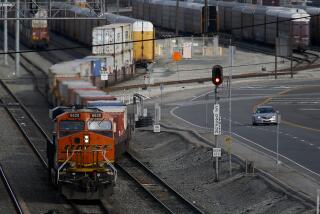Bad-Air Recipe: Mile-High City, Cars, Fireplaces
DENVER — Denver’s elevation and cold winters, its far-flung suburbs and drive-yourself life style are making it tough for the city to meet federal clean air standards by the Dec. 31 deadline.
The stakes are high in the Mile High City, where breathtaking views of the Rocky Mountains are sometimes seen through the worst carbon-monoxide problem in the nation. Colorado stands to lose $30 million in federal highway funds if Denver cannot clean up its air by the end of this year.
Last winter--the worst season for the city’s air--the seven-county area around Denver was out of compliance with the federal Clean Air Act on 35 days, preliminary figures show. Only one violation a year is allowed.
The Denver metropolitan area has tried voluntary limits on driving and wood-burning, but the violations have continued. Now, year-round daylight saving time, a high-oxygen fuels program and tightened auto emissions standards are under consideration.
Invisible Pollutant
Carbon monoxide is an invisible, odorless gas that can cause or aggravate many health problems, including heart and lung disease. Pregnant women and elderly people are considered particularly susceptible to its poison.
The city is deemed out of compliance every day that carbon monoxide in its air averages more than 9 parts per million over an eight-hour period, or when it reaches a level of 35 ppm for one hour.
Mayor Federico Pena and other officials say the city has made strides: In 1975, the city had 100 days when its air violated the federal standard, and in recent years there have been less than half that number of bad-air days.
“We strongly believe we have taken so many steps that we shouldn’t be treated negatively,” Pena said. “We don’t want to be penalized for making good-faith efforts, and we don’t want (clean-air) standards softened or weakened.”
Pena believes Denver residents are beginning to make sacrifices for the sake of cleaning up the air, and will continue to do so. “To begin to make adjustments in life style in a part of the country where the ‘one person, one car’ rule applied for so long--I’m pleased with it. It’s a big step forward,” he said.
Geography Traps Air
Denver lies in the South Platte River Valley. Its suburbs extend east into the plains and west to the foothills of the Rockies. In the winter, the region is susceptible to lingering temperature inversions, in which warm air traps cooler air and with it auto exhaust, smoke from wood fires and industrial pollution.
Sometimes the air is stagnant for days, because the mountains form a barrier and there is not enough sunlight to warm the ground and break up the inversion. On those days, the infamous “Brown Cloud” settles over the area.
About 75% of Denver’s carbon monoxide is produced by automobiles; about 16% by wood burning.
Denver has no rapid transit system and fewer passengers per car trip than any other city in the nation. The metropolitan area had 1.6 million residents in 1980 and is still growing.
The Regional Transportation District bus system is carrying fewer passengers than it was two years ago. Ridership on the buses declined in 1986, to 21.16 boardings per hour.
Denver began its Better Air Campaign in 1984 to promote voluntary reductions in automobile use. From mid-November through mid-January of each year, residents have been exhorted to leave their cars at home one day a week and use car pools or buses.
Colorado Department of Health figures indicate that the 1986-87 season saw an 8% decrease in traffic, which led to a 9% reduction in carbon monoxide levels.
The traffic reduction fell short of the goal of 12%, but Denver officials are upbeat about the results of the clean-air effort.
“It’s a matter of expectations,” said Tony Massaro, Denver director of environmental affairs. “Anytime you have a strategy that costs $500,000 a year and reduces pollution 9%, it’s a very cost-effective, successful strategy.”
Denver and two suburbs, Lakewood and Boulder, have banned wood burning on high-pollution days, and Aurora is considering a similar ordinance. Denver is testing a high-oxygen gasoline in 50 of its cars and trucks, and its bus system will switch to a cleaner-burning type of diesel fuel next winter.
“People traded off last year. They didn’t burn their fireplaces instead of not driving--we need them all,” Massaro said.
“Next year, when you have oxygenated fuel in your tank, it doesn’t mean you can drive all you want. People have to do all the strategies, not pick and choose.”
“I feel comfortable that we in the Denver metro area . . . are making every reasonable effort for compliance,” said Brad Beckham, director of the state Health Department’s air pollution control division.
Beckham said new programs include more stringent auto emissions rules, use of daylight saving time year-round, improvement of car pool lanes and bus park-and-ride facilities, and promotion of ride-sharing systems for major employers.
“There are a lot of things we’re doing above and beyond what other areas are doing, and we’ll continue,” Beckham said.
More to Read
Sign up for Essential California
The most important California stories and recommendations in your inbox every morning.
You may occasionally receive promotional content from the Los Angeles Times.










